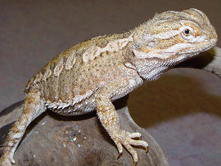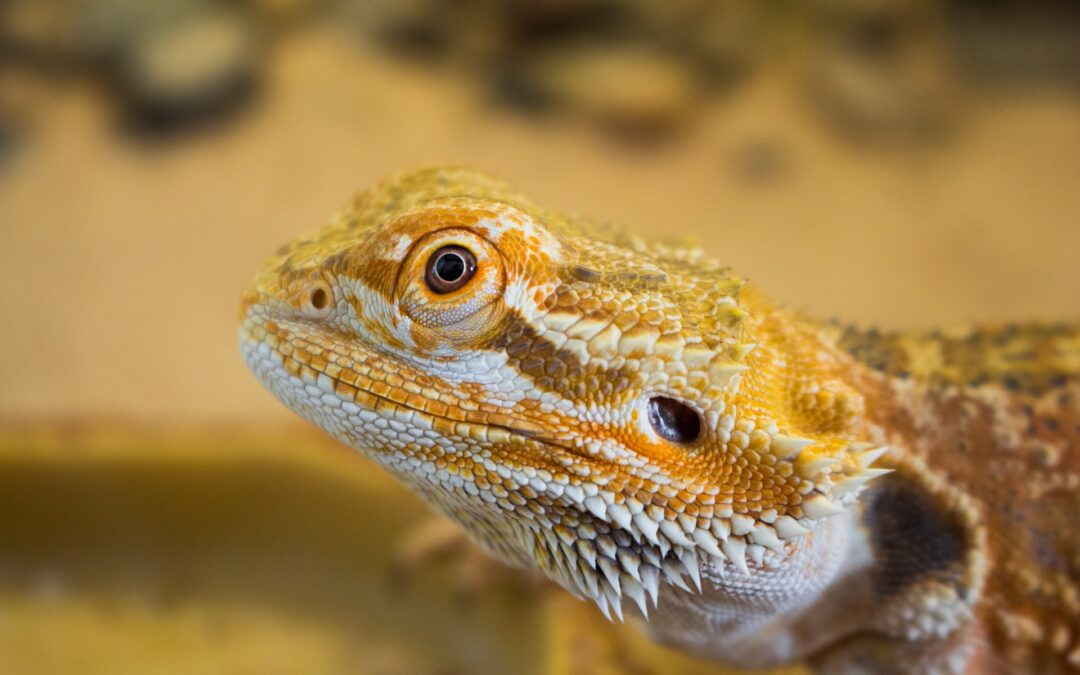Photos and edited by Susan Horton, DVM
There are 20 different species of bearded dragons in Australia but only three of those species are commonly found in the pet industry. The Inland or Central Bearded Dragon (Pogona vitticeps) is the most common lizard kept and recommended for keeping in the pet industry due to its gentle disposition and relatively friendly manner when being handled. The Bearded Dragon (Pogona barbata) and Lawson’s Dragon (Pogona henrylawsoni) are also found in the pet industry but in much smaller numbers. For the purpose of this hand out however, bearded dragon or “beardie” will stand for the Inland or Central Bearded Dragon.

Natural History
Beardies are found throughout the semi-desert regions of Central and Southern Australia along forest edges too. In Australia , they are frequently found basking on tree stumps, fences, railings, and any other object that juts out of the ground.
Description
Bearded dragons are well muscled, broad headed, flat bodied lizards. Their signature “beard” is under the chin and consists of small spikes that jut out when the throat is inflated. The head is spined as well as the sides of the abdomen. Some breeders sell Leather Backs which are genetically designed to have a softer feel by eliminating some of the spikes. Juveniles lack a beard. The tail is half the length of the lizard and incapable of autotomy (a defense mechanism found in some lizards also known as “dropping the tail”). The bearded dragon has become quite popular in the breeding industry for morphs (different variations of color not created in the wild). The most common morphs are Red/Gold, Sandfire, Sandfire Pastel, and Gold Headlight Iris. These lizards have an average life span of 5-9 years although 12 years is no longer uncommon.
Feeding
Adult bearded dragons are omnivorous while hatchlings and juveniles are more insectivorous. Hatchling up to two months old should be fed two to three times a day a mixture of insects and healthy greens. Several feedings is especially advantageous when there are several dragons housed together. Proper growth is achieved through several small meals with smaller prey items versus one large meal with a large prey item. Adults, however, can be fed a salad of greens such as romaine lettuce, escarole, Swiss chard, mustard greens, and turnip greens with a small amount of other vegetables and fruits such as carrots, peas, strawberries, blueberries, melon, and squash once a day. Edible flowers such as squash blossoms are also okay to offer and generally relished. Insects such as crickets, meal worms, and feeder roaches (such as dubias) are excellent protein sources and should be offered every other day to every three days depending on your lizard’s body condition (thin, normal, or obese) and your vet’s recommendation.
Gut loading feeder insects with healthy calcium rich greens such as kale and Swiss chard is required for a positive calcium to phosphorous ratio (this prevents and corrects metabolic bone disease). Feeder insects must be dusted with a calcium supplement (one without phosphorous) 3-4 times a week and a multivitamin once a week. Some owners feed small pinkie mice to their larger adults. It is recommended to limit the pinkie feedings to an occasional treat or once every two week feeding due to the higher fat content. The most important rule to remember when it comes to insect and rodent prey is that the feeder can not be longer than the distance between the dragon’s eyes! This helps prevent dangerous impaction and digestion issues including choking.

Enclosure
Hatchlings grow fast but can be maintained well in a 10 gallon aquarium at a young age while growing into adults that can be housed in aquariums as large as 75 or 120 gallons! The smallest cage for a singly housed adult is a 30 gallon breeder although larger is preferred. Multiple lizards housed together require more room to allow for escape from each other. Custom enclosures for adults made of wood or melamine should be 72” long, 16 inches wide and 17 inches high according to some sources. Ventilation is important regardless of the size of the enclosure. It is recommended that aquariums have 3 sides covered to prevent escape attempts and allow for a feeling of security.
During the warmer months, beardies can be housed outside in an outdoor set-up created with wood and wire mesh. There are several blue print plans available on the internet for these enclosures. Please, do not take the aquarium outside! This can cause lethal hyperthermia especially in direct sunlight. Frequent supervision is required ensure the health of your beardie. These enclosures must be protected from large amounts of rainfall and predators. The optimal positioning allows for some shade to be available as well.
Substrate
It is never recommended to keep bearded dragons on a sand substrate even the calcium sand sold in pet stores. Life threatening impactions are frequently caused by accidental ingestion of particulate bedding including sand, coconut fiber substrate, and crushed walnut bedding. A better substrate that is easier to clean is indoor/outdoor carpet, potting soil (requires weekly changing), and butcher paper. The substrate should be spot cleaned daily and changed as needed or after 7 days, whichever comes first.
Temperature and Humidity
The temperature for bearded dragons during the day should be around 80-85 degrees Fahrenheit and drops to 75 degrees Fahrenheit at night. The basking site should be around 88-95 F. Two thermometers should be used in the cage. One placed at the level of the basking site and the other on the cool end of the tank an inch above the substrate. It is highly recommended to regulate the temperature using a thermostat. The primary heat source should be an over head basking light or ceramic heat emitter. Secondary heat if needed ideally comes from under tank heaters under half the tank. Do not use electrical heating rocks due to the extremely likely chance the bearded dragon will develop thermal burns.
The humidity in the cage should be maintained between 40 and 60%. This can be achieved by placing a water dish in the enclosure, preferably one the lizard can soak in, and daily misting. A hygrometer is highly recommended.
UVB
UVB lights are necessary for the proper growth and maintenance of bearded dragons. The ultraviolet B radiation stimulates the synthesis of calcium. The best source of UVB is the sun but only when the animal is outside and directly in the sun light. Never place the cage by a window. The UVB light is filtered out through glass and the chance of over heating the enclosure is extremely high. The recommended bulb for a hatchling and sub-adult is a Repti Sun 10.0 and a Repti Sun 5.0 for adults. The bulb must be changed yearly as the strength of the UVB will deteriorate with time despite the bulb giving off visible light. Placement of the bulb should be overhead and no more than 10 inches away from the basking site. The light cycle for bearded dragons should be 12 hours of light with 12 hours of darkness. Mercury vapor bulbs work well, too.
Cage Accessories
Dried wood branches are appreciated by most bearded dragons as the species is a modest climber. A large rock under the basking light makes a wonderful basking site. Live plants such as aloe and palms can be added to the enclosure. Artificial plants are easily disinfected and make appropriate accessories. Most beardies will utilize a half log hiding area. Custom and creative hides can be made as well.
Grouping
Although we at Chicago Exotics recommend single housing we understand that group housing is a popular option among reptile keepers. Males are typically very territorial and fighting comes to a head during breeding season. It has been noted that a submissive male can be housed with a dominant male but it is still best to separate them. Dominance displays include inflation of the throat (also a defensive move) and head bobbing. Displays of submission are seen as arm waving which as males become older disappears but is retained in females throughout their life.
Females, once they establish a hierarchy seem to live with each other without incident as long as there are multiple feeding stations and enough room. Bearded dragons can also be housed along or in a group of several females to one male. The hierarchy is often very clear with bearded dragons as the dominant lizard will bask higher than the others as well as eat first. It is always recommended to have multiple feeding stations if more than one beardie is housed together.
Sexing
Bearded dragons can reach sexual maturity by 6 months of age and as late as 12 months. Males have large femoral (under side of the thigh) pores and a thicker tail base. Females have small or non-existent femoral pores and a slender smoothly tapered tail. As the lizards mature, males will develop broader heads as well.
Reproduction
Breeding is triggered by an increase in the temperature generally in late winter and early spring and lasts around four months. Females indicate receptivity by laying flat on the ground and raising their tails. The male will hold the female by biting her neck and using his tail to push their cloacas together. Copulation is not long. Bearded dragons are capable of laying several clutches (as many as 5!) in one four month season with around 20 eggs a clutch! Females will become restless and aimlessly wander the cage digging at random and go off food right before eggs are laid. A nesting box of moist sand helps stimulate laying of the eggs. Females will lay eggs regardless of fertilization but most females reabsorb unfertilized follicles. Fertile eggs if incubated properly at 84 degrees Fahrenheit will hatch around 55-75 days. Eggs must be removed from the enclosure and kept moist and protected. Call Chicago Exotics and ask for Erica if you have questions about incubating eggs.
Grooming and Handling
Bearded dragons will learn to tolerate routine handling. When handled on a daily basis, they seem to become more relaxed as time goes on, and cleaning the enclosure is simplified when the animal is docile. Bearded dragon skin is very rough, so light gloves and long sleeves should be worn to protect against mild scratches. Their toenails also become needle-sharp, and should be trimmed every few weeks. Finally, because all reptiles are potentially infected with Salmonella bacteria, which can be transmitted from reptiles to humans, routine cleanliness and hygiene are essential.
Sources and Resources to Utilize
Lizards Volume 1, Manfred Rogner
Keeping and Breeding Lizards, Chris Mattison
Reptile Medicine and Surgery, Doug Mader
Manual of Exotic Pet Practice, Mark Mitchell and Thomas N.Tully Jr.
The Bearded Dragon Manual, Philippe de Vosjoli
Bearded Dragons: A Complete Guide to Pogona Vitticeps, Philip Purser
King Snake Forum www.kingsnake.com

